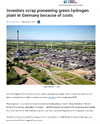- Joined
- 3 July 2009
- Posts
- 28,647
- Reactions
- 26,282
The other factor that may come into play is, the wind farm generation may be required by the grid, hydrogen isn't going to be sensible until the grid load is adequately covered.
A lot of these things are pet projects, with no viable economic sense.





 Frankly I think there is a fair bit of water to flow before we see these fully fledged 100 MW units in operation. They have pilot plants but it would be an amazing achievement to go to full giga factory production without normal engineering hitches.
Frankly I think there is a fair bit of water to flow before we see these fully fledged 100 MW units in operation. They have pilot plants but it would be an amazing achievement to go to full giga factory production without normal engineering hitches.


